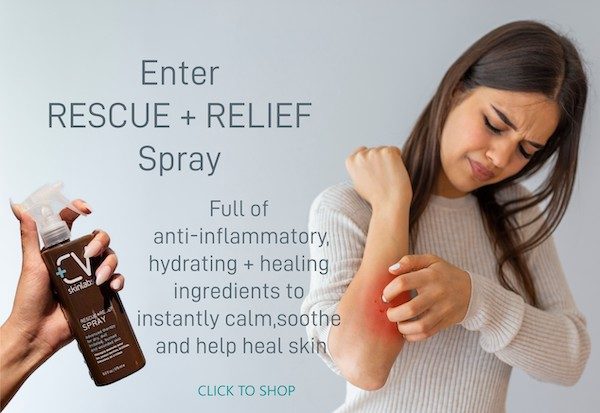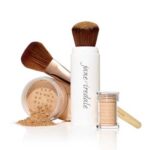The research is in: COVID-19 long-haulers may experience skin sensitivity due to COVID-19.
Symptoms include rash, hives, redness, inflammation and more.
What’s going on here and can you do something about it?
Covid skin sensitivity: what is it?
Although considered a rare side effect of the COVID-19 virus, skin sensitivity has been reported in scientific journals and by major medical groups.
The Mayo Clinicnotes, for example, that the most common skin changes associated with the virus are “a flat rash covered in small bumps,” as well as hives and even discolored patches on the fingers and toes — what is sometimes called “COVID toes.”
Blisters, itching, rough skin, or painful bumps may also occur and may last 10 to 14 days or longer.
What does the research say about skin sensitivity in COVID?
In a 2020 reviewresearchers looked at 43 studies on COVID-19 and analyzed the data on skin problems. They found that 1.0 percent of patients were affected. Looking at case reports, 48 of 54 patients (88.8 percent) showed skin symptoms of the virus. Rash and hives were the most commonly reported side effects.
More specifically, the researchers noted that patients may experience red spots on the hands, blisters on the torso, itchy hives, red patches of itchy skin, and swollen, itchy blisters. The researchers are still unsure whether these symptoms are directly related to the virus or whether they are complications of the infection.
Also in 2020 researchers reported on data out of 990 cases from 39 countries of COVID-19 patients with skin symptoms. The patients experienced a broad spectrum of problems that lasted for varying lengths of time, including hives, COVID toes, and scaly papules and plaques.
Symptoms varied depending on how severe the infection was. The papules and plaques were more common in patients who were hospitalized because of the infection – suggesting inflammation was involved – while those with COVID toes were likely to have experienced a mild form of the disease.
In a Review 2021researchers looked at 87 studies, which included data from 895 patients with skin lesions associated with COVID-19. The most common symptom was a rash, although patients also experienced hives and other skin problems. The lesions seemed to occur more often in the first four weeks after the onset of the virus, although some patients developed them later.
Covid skin sensitivity: COVID toes
In a more recent one Review 2022researchers looked at data from 128 studies, including nearly 5,000 cases of so-called chilblain-like lesions (CLL), or what is commonly known as COVID toes.
Chilblains is a condition that causes inflamed, swollen areas and blistering on the hands and feet. It is caused by exposure to moist air that is cold but not freezing. Symptoms include swelling, pain or stinging, changes in skin color, sores or blisters, and small itchy spots on the skin.
Scientists have noticed that the same type of symptom appears in some people who had the COVID-19 infection but who had no exposure to cold, moist air. In the 2022 review, they found that this symptom most commonly affected patients with an average age of 25 years and that women were slightly more likely to experience it.
Although this side effect is called COVID toes, it can sometimes affect the fingers as well. Fortunately, treatment usually resolved the problem within about 16-17 days. The most commonly reported treatments were topical steroids, oral analgesics, skin heating, topical antimicrobials, oral antihistamines, and other medications.
It is still unclear whether this symptom is directly related to the disease, as research shows that those who have it do not always test positive for the virus that causes COVID-19. We need more studies to understand it better.
What does a COVID result look like?
If you’ve been diagnosed with COVID-19 — and especially if you’ve had a difficult time with the virus (for example, you’ve been hospitalized) — you may have noticed skin problems associated with it. If you are still experiencing rashes, redness and itching for which you have no other explanation, you may be suffering from skin symptoms of long COVID.
Someone with a COVID rash may have the following symptoms:
- Itchy, raised bumps
- Small blisters that look like chickenpox
- Spotty areas of discoloration
- Itchy or painful skin
- Small red, purple or dark brown spots
- Hives
From what we know so far, it seems that these symptoms usually go away within a few weeks. However, for some, a COVID rash can last for many months.

Why would COVID cause skin symptoms?
Scientists are still learning about the different ways the virus affects the human body. What seems clear so far is that some skin conditions are likely related to the inflammation that occurs when the immune system tries to ward off the disease. Inflammation in the body can easily translate into inflammation in the skin, resulting in redness, swelling, rashes and hives. Scientists believe that inflammation is also the cause of COVID toes.
Some of the other symptoms – such as bruise-like rashes – appear to be caused by blood clots, which are also a side effect of COVID-19 in some people. And because antibodies fight the virus, they can also damage blood vessel walls, causing a rash.
Why do some skin symptoms last so long?
Scientists are still trying to solve all the puzzles of the long COVID virus. So far, they just don’t know why some people suffer from these types of symptoms for much longer than others. Some suspect that the virus triggers another process in the body that continues to cause symptoms. It seems less likely that the immune system is still fighting the virus many months later.
COVID Skin Sensitivity: How to Make Your Skin Feel Better
It is always best to talk to your doctor and/or dermatologist about any skin symptoms you are experiencing. They may have medications that can help.
In the meantime, you’ll try to control any inflammation the skin is experiencing while helping to heal the outer barrier, which is most likely damaged.
The best way to do that is:
- Reduce the products you use. Opt for a minimal routine consisting of a gentle cleanser, toner and moisturizer, and give your skin a break from heavier treatments that contain acids and retinol.
- Avoid alcohol toners. We recommend our Rescue + Relief Spray as it helps tame inflammation and cools a hot rash. Like all CV Skinlabs products, it contains the exclusive Tri-Rescue Complex, a powerful blend of anti-inflammatory ingredients that soothe and help repair inflammatory skin conditions.
- Choose a nourishing moisturizer. Any moisturizer will not work. You need one that helps calm inflammation and promote healing and recovery. We recommend our Calming Moisture and Body Repair Lotion. They also contain the anti-inflammatory Tri-Rescue Complex, plus natural shea butter, soothing extracts, healing vitamin E and aloe to help soothe and soften troubled skin.
Do you have experience with COVID skin sensitivity? How did you manage it?
Featured image by Freepik.






